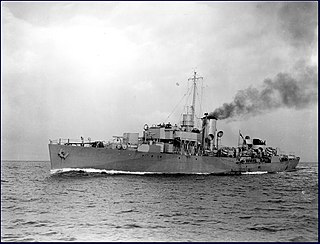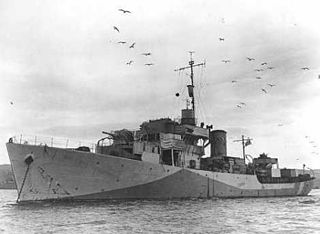Background
Flower-class corvettes like Pictou serving with the Royal Canadian Navy during the Second World War were different from earlier and more traditional sail-driven corvettes. [2] [3] [4] The "corvette" designation was created by the French as a class of small warships; the Royal Navy borrowed the term for a period but discontinued its use in 1877. [5] During the hurried preparations for war in the late 1930s, Winston Churchill reactivated the corvette class, needing a name for smaller ships used in an escort capacity, in this case based on a whaling ship design. [6] The generic name "flower" was used to designate the class of these ships, which – in the Royal Navy – were named after flowering plants. [7]
Corvettes commissioned by the Royal Canadian Navy during the Second World War were named after communities for the most part, to better represent the people who took part in building them. This idea was put forth by Admiral Percy W. Nelles. Sponsors were commonly associated with the community for which the ship was named. Royal Navy corvettes were designed as open sea escorts, while Canadian corvettes were developed for coastal auxiliary roles which was exemplified by their minesweeping gear. Eventually the Canadian corvettes would be modified to allow them to perform better on the open seas. [8]
Construction
Pictou was ordered on 22 January 1940 as part of the 1939–1940 Flower-class building program. She was laid down by George T. Davie & Sons Ltd. at Lauzon on 12 July 1940 and launched on 5 October 1940. She was commissioned into the RCN on 29 April 1941 at Quebec City, Quebec. [9] During her career, Pictou had several periods in the dockyard. The first took place after being sent back three times during convoy duties with mechanical problems. The repairs began at Halifax Dockyard and were completed at Liverpool, Nova Scotia. The second period in refit was due to a collision. Repairs began in August 1942 and were completed in September. Her third major period of overhaul began in December 1942 after developing serious mechanical issues while on convoy escort. She needed emergency repairs at Halifax before heading to Liverpool to commence a serious refit. The final period of yard work of Pictou's career took place from January to 31 March 1944 at New York during which her fo'c'sle was extended. [10]
"When the RCN took over from the British in Newfoundland in mid-1941, [Commodore Leonard W. Murray] saw escort ships streaming from the builders - and the shortage of skippers steadily worsening. For want of experienced captains, the four-month-old corvette Pictou lay idle in St John's. Murray summoned Lieutenant A.G.S.Griffin, temporarily in charge. "Just want to let you know I'm doing all I can to find another CO to get you to sea," said Murray. "Sir -," Griffin swallowed hard. "Let me have her." Murray reached a decision in seconds. "All right, I'll take a chance on you. She's yours." And he made a corvette captain of a life insurance man ... Now, with only eight weeks' sea time, the "old man", at 28, he took her to sea." [11]
Service history
After completing workups, Pictou was assigned to the Newfoundland Escort Force. She was one of the first two corvettes to become trans-Atlantic Ocean escorts. She spent the rest of 1941 as an ocean convoy escort. She was sent back to port three times with mechanical difficulties which led to her being sent for major repairs. In June 1942 she joined the Mid-Ocean Escort Force (MOEF) as part of escort group C-4. [10]
On 5 August 1942, Pictou was rammed in fog by the Norwegian merchant SS Hindanger near St. John's. She suffered severe damage to her stern and was sent back to port for repairs. After workups she joined MOEF escort group C-2. In December 1942 she developed severe mechanical problems again and departed for repairs and then refit, not returning to service until May 1943. [10]
In May 1943 Pictou joined MOEF escort group C-3 and remained with them until departing for refit in January 1944. After workups in Bermuda she joined the Western Local Escort Force escort group W-5 in June 1944 and remained with them until the end of the war. [10]
Pictou was paid off from the RCN on 12 July 1945 at Sorel, Quebec. [10] She was sold for mercantile conversion and in 1950 reappeared as the 708 GRT whalecatcher Olympic Chaser. [12] She was renamed in 1956 as Otori Maru No. 7. In 1963 she was converted to a barge. [9] [12]

HMCS Riviere du Loup was a modified Flower-class corvette that served with the Royal Canadian Navy during the Second World War. She fought primarily in the Battle of the Atlantic as a convoy escort. She was named for Rivière-du-Loup, Quebec.

HMCS Sudbury was a Flower-class corvette that served the Royal Canadian Navy during the Second World War. She served primarily in the Battle of the Atlantic as a convoy escort. She was named for Sudbury, Ontario.

HMCS Rimouski was a Royal Canadian Navy Flower-class corvette which took part in convoy escort duties during the Second World War. She fought primarily in the Battle of the Atlantic. She was named after Rimouski, Quebec.

HMCS Long Branch was a modified Flower-class corvette that served in the Royal Canadian Navy during the Second World War. She was used primarily as a convoy escort in the Battle of the Atlantic. She was laid down as HMS Candytuft but was transferred to the RCN on 5 January 1944 before completion. She was named for Long Branch, Ontario, a village that was eventually amalgamated into Toronto, Ontario.

HMCS Moose Jaw was a Royal Canadian Navy Flower-class corvette which took part in convoy escort duties during the Second World War. Together with HMCS Chambly, she achieved the RCN's first U-boat kill of the war. She was named after Moose Jaw, Saskatchewan.

HMCS Regina was a Royal Canadian Navy revised Flower-class corvette which took part in convoy escort duties during the Second World War. She fought primarily in the Battle of the Atlantic. She was named for Regina, Saskatchewan.

HMCS Halifax was a Royal Canadian Navy revised Flower-class corvette which took part in convoy escort duties during the Second World War. She served primarily in the Battle of the Atlantic. She was named for Halifax, Nova Scotia.

HMCS Summerside was a Flower-class corvette that served the Royal Canadian Navy during the Second World War. She served in several naval theatres of the war. She was named for Summerside, Prince Edward Island. Following the end of the war, the ship was sold for scrap and broken up.

HMCS Camrose was a Royal Canadian Navy Flower-class corvette which took part in convoy escort duties during the Second World War. She was named for Camrose, Alberta.

HMCS Mayflower was a Flower-class corvette that served mainly in the Royal Canadian Navy during the Second World War but began her service with the Royal Navy. She saw action primarily in the Battle of the Atlantic as an ocean escort. She was named after the flowering plant Maianthemum canadense.

HMCS Trillium was a Flower-class corvette that served in the Royal Canadian Navy during the Second World War. She served mainly as a convoy escort in the Battle of the Atlantic. She was one of ten corvettes loaned to the Canadian navy by the Royal Navy and the only one which remained an ocean escort throughout the war. She was named after the flowering plant genus Trillium, which includes wakerobin, tri flower, and birthroot.

HMCS Rosthern was a Flower-class corvette that served in the Royal Canadian Navy during the Second World War. She served primarily in the Battle of the Atlantic as a convoy escort. She is named for Rosthern, Saskatchewan.

HMCS Wetaskiwin was a Flower-class corvette of the Royal Canadian Navy that served during the Second World War. She served primarily as a convoy escort in the Battle of the Atlantic. She was named after the city of Wetaskiwin, Alberta. Wetaskiwin was the first Pacific coast built corvette to enter service with the Royal Canadian Navy.

HMCS Galt was a Flower-class corvette of the Royal Canadian Navy that served during the Second World War. She saw action primarily in the Battle of the Atlantic. She was named after the city of Galt, Ontario.

HMCS Chambly was a Flower-class corvette serving in the Royal Canadian Navy. She was ordered from Canadian Vickers Ltd. in Montreal, laid down on 20 February 1940, launched on 29 July, and commissioned on 18 December 1940, named after the city of Chambly, Quebec. Chambly escorted trade convoys between Halifax Harbour and the Western Approaches through the battle of the Atlantic and, together with HMCS Moose Jaw, achieved the RCN's first U-boat kill of the war.

HMCS Drumheller was a Flower-class corvette that served with the Royal Canadian Navy during the Second World War. She served in several theatres, including the Battle of the Atlantic as an ocean escort. She was named for Drumheller, Alberta.

HMCS Dunvegan was a Flower-class corvette that served with the Royal Canadian Navy during the Second World War. She served primarily in the Battle of the Atlantic. After the war she was sold to the Venezuelan Navy. She was named for Dunvegan, Inverness County, Nova Scotia.

HMCS Fennel was a Flower-class corvette that served primarily with the Royal Canadian Navy during the Second World War. Originally commissioned into the Royal Navy, she served as an ocean escort in the Battle of the Atlantic.

HMCS Sorel was a Flower-class corvette that served with the Royal Canadian Navy during the Second World War. She served primarily in the Battle of the Atlantic as an ocean escort. She is named for Sorel, Quebec.

HMCS La Malbaie was a Royal Canadian Navy revised Flower-class corvette which took part in convoy escort duties during the Second World War. She fought primarily in the Battle of the Atlantic. She was named for La Malbaie, Quebec. She was originally named Fort William but her name was changed before commissioning.




















